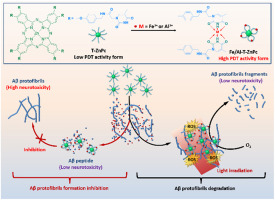Talanta ( IF 6.1 ) Pub Date : 2018-08-16 , DOI: 10.1016/j.talanta.2018.08.037 Qichen Zhan , Xianqing Shi , Ting Wang , Jinhui Hu , Jiahong Zhou , Lin Zhou , Shaohua Wei

|
The formation and accumulation of toxic amyloid beta (Aβ) protofibrils in brain is recognized as the pathological hallmark of alzheimer’s disease (AD). Recent research indicated that photodynamic therapy (PDT) has potential to treat AD because reactive oxygen species (ROS) generated by photosensitizers (PS) could degrades Aβ protofibrils. Al3+ and Fe3+ were found at markedly high levels on and around Aβ protofibrils comparing with the normal part of brain. Based on this, a thymine modified Zn phthalocyanine (T-ZnPc), which can specific recognize and has strong affinity with Fe3+ and Al3+, was designed and synthesized. The recognize, affinity, Aβ protofibrils degradation and neuro protection process were monitored via ultraviolet absorption spectrometry (UV), fluorescence emission spectrum, transmission electron microscopy (TEM), flow cytometer and thiazolyl blue tetrazolium bromide (MTT) assay. The results revealed that such affinity effect greatly increases the molar extinction coefficient (from 1.70 × 104 to 4.67 × 104 and 3.30 × 104 after forming Fe-T-ZnPc and Al-T-ZnPc) and activates PDT activity of T-ZnPc to generate abundant ROS to degrade Aβ protofibrils (62% and 81% degradation by Al-T-ZnPc and Fe-T-ZnPc) and prevent its neurotoxicity based on the statistical differences analysis. Besides, T-ZnPc could inhibit new Aβ protofibrils formation and the chelation effect could reduce the free Fe3+ and Al3+ concentration in brain, which could be also helpful for AD treatment.
中文翻译:

胸腺嘧啶修饰的酞菁对Aβ原纤维光降解和Aβ肽聚集抑制的设计与合成
大脑中有毒的淀粉样β(Aβ)原纤维的形成和积累被认为是阿尔茨海默氏病(AD)的病理标志。最近的研究表明,光动力疗法(PDT)具有治疗AD的潜力,因为光敏剂(PS)产生的活性氧(ROS)可以降解Aβ原纤维。与大脑的正常部位相比,Aβ原纤维及其周围的Al 3+和Fe 3+含量显着较高。基于此,可特异性识别Fe 3+和Al 3+并具有强亲和力的胸腺嘧啶修饰的Zn酞菁锌(T-ZnPc)。,是设计和合成的。通过紫外吸收光谱(UV),荧光发射光谱,透射电子显微镜(TEM),流式细胞仪和噻唑基蓝四唑鎓溴化物(MTT)分析来监测识别,亲和力,Aβ原纤维降解和神经保护过程。结果表明,这种亲和力效应极大地增加了摩尔消光系数(从1.70×10 4到4.67×10 4和3.30×10 4)。形成Fe-T-ZnPc和Al-T-ZnPc之后并激活T-ZnPc的PDT活性以生成大量的ROS降解Aβ原纤维(Al-T-ZnPc和Fe-T-ZnPc分别降解62%和81%)并根据统计差异分析预防其神经毒性。此外,T-ZnPc可抑制新的Aβ原纤维的形成,螯合作用可降低脑中游离Fe 3+和Al 3+的浓度,也可能对AD治疗有帮助。


























 京公网安备 11010802027423号
京公网安备 11010802027423号